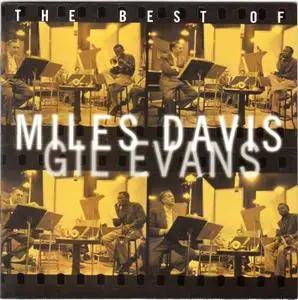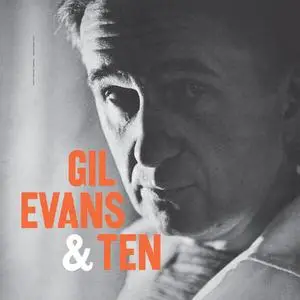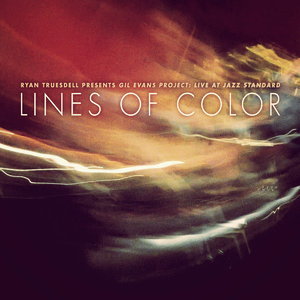Gil Evans
Gil Evans Orchestra - New Bottle, Old Wine (1958/2021) [Official Digital Download 24/96] Vinyl & HR
Posted by pyatak at Dec. 1, 2024
Gil Evans Orchestra - New Bottle, Old Wine (1958/2021) [Official Digital Download 24/96]
FLAC (tracks) 24-bit/96 kHz | Front Cover | Time - 76:25 minutes | 1,43 GB
Jazz | Studio Master, Official Digital Download
FLAC (tracks) 24-bit/96 kHz | Front Cover | Time - 76:25 minutes | 1,43 GB
Jazz | Studio Master, Official Digital Download
New Bottle Old Wine is an album by jazz composer, arranger, conductor and pianist Gil Evans recorded in 1958 by Evans with an orchestra.
Collaboration: Helen Merrill - Gil Evans - 1988 Music
Posted by mfrwiz at Dec. 24, 2009
Collaboration: Helen Merrill - Gil Evans - 1988
Lossless (WavPack Image File + Cue + Log + Wavpack Files Check Utility Included): 253 Mb | EAC Secure Mode Rip | Mp3 (Fraunhofer IIS - 320 kbps): 153 Mb | HQ Scans | Rar Files (3% Recovery)
Audio CD (May 16, 1988) Recorded: August 18,25,26, 1987 - Number of Discs: 1 - Label: Emarcy - Catalog Number: 834 205 2
Jazz, Vocal Jazz
Lossless (WavPack Image File + Cue + Log + Wavpack Files Check Utility Included): 253 Mb | EAC Secure Mode Rip | Mp3 (Fraunhofer IIS - 320 kbps): 153 Mb | HQ Scans | Rar Files (3% Recovery)
Audio CD (May 16, 1988) Recorded: August 18,25,26, 1987 - Number of Discs: 1 - Label: Emarcy - Catalog Number: 834 205 2
Jazz, Vocal Jazz
Miles Davis & Gil Evans - The Best Of Miles Davis & Gil Evans (1997) Music
Posted by Domestos at March 28, 2020
Miles Davis & Gil Evans - The Best Of Miles Davis & Gil Evans (1997)
EAC Rip | FLAC (tracks+.cue, log) ~ 336.01 Mb + 17.42 Mb (Scans) | 01:01:03
Hard Bop, Big Band | Country: Canada | Label: Columbia (Legacy) - CK 67425
EAC Rip | FLAC (tracks+.cue, log) ~ 336.01 Mb + 17.42 Mb (Scans) | 01:01:03
Hard Bop, Big Band | Country: Canada | Label: Columbia (Legacy) - CK 67425
The Best of Miles Davis and Gil Evans collects a dozen highlights from 1996's lavish six-disc set The Complete Columbia Studio Recordings, including performances from the masterpieces Miles Ahead, Porgy and Bess and Sketches From Spain. ~ AllMusic Review by Jason Ankeny
Gil Evans - Gil Evans & Ten (1957/2023) Music
Posted by Fizzpop at Nov. 30, 2023
Gil Evans - Gil Evans & Ten (1957/2023)
WEB FLAC (Tracks) 159 MB | Cover | 33:25 | MP3 CBR 320 kbps | 78 MB
Jazz | Label: Craft Recordings
WEB FLAC (Tracks) 159 MB | Cover | 33:25 | MP3 CBR 320 kbps | 78 MB
Jazz | Label: Craft Recordings
Gil Evans & Ten (also released as Big Stuff and Gil Evans + Ten) is the first album by pianist, conductor, arranger and composer Gil Evans as a leader, released on the Prestige label in 1957. It features Evans' arrangements of five standards and one original composition performed by Evans, Steve Lacy, John Carisi, Jack Koven, Jimmy Cleveland, Bart Varsalona, Willie Ruff, Lee Konitz, Dave Kurtzer, Paul Chambers, Jo Jones, Louis Mucci and Nick Stabulas.
Gil Evans - Gil Evans & Ten (1957/2023) [Official Digital Download 24/192] Vinyl & HR
Posted by pyatak at Nov. 30, 2023
Gil Evans - Gil Evans & Ten (1957/2023) [Official Digital Download 24/192]
FLAC (tracks) 24-bit/192 kHz | Front Cover | Time - 33:25 minutes | 1,32 GB
Jazz | Studio Master, Official Digital Download
FLAC (tracks) 24-bit/192 kHz | Front Cover | Time - 33:25 minutes | 1,32 GB
Jazz | Studio Master, Official Digital Download
Gil Evans & Ten (also released as Big Stuff and Gil Evans + Ten) is the first album by pianist, conductor, arranger and composer Gil Evans as a leader, released on the Prestige label in 1957.
The Gil Evans Orchestra - Live at Fabrik Hamburg 1986 (2022) [Official Digital Download] Vinyl & HR
Posted by pyatak at July 26, 2023
The Gil Evans Orchestra - Live at Fabrik Hamburg 1986 (2022) [Official Digital Download]
FLAC (tracks) 24-bit/48 kHz | Front Cover | Time - 02:10:58 minutes | 1,55 GB
Jazz | Studio Master, Official Digital Download
FLAC (tracks) 24-bit/48 kHz | Front Cover | Time - 02:10:58 minutes | 1,55 GB
Jazz | Studio Master, Official Digital Download
Second release of the "Live At Fabrik Hamburg" series on JAZZLINE in cooperation with the legendary venue and NDR Kultur - the concert of GIL EVANS in 16-piece all-star line-up from 1986
Sting & Gil Evans: Strange Fruit - Live At Perugia Jazz Festival 11. 07.1987 (2006) [Repost] Music
Posted by robi62 at April 12, 2013
Sting & Gil Evans: Strange Fruit - Live At Perugia Jazz Festival 11. 07.1987 (2006) [Repost]
Video: PAL, MPEG Video at 5 000 Kbps, 720 x 576 (1.333) at 25.000 fps | Audio: AC-3 2 channels at 192 Kbps, 48.0 KHz
Genre: Jazz, Rock | Label: Quantum Leap | Copy: Untouched | Release Date: 13 Nov 2006 | Runtime: 101 min. | 3,81 GB (DVD5)
Video: PAL, MPEG Video at 5 000 Kbps, 720 x 576 (1.333) at 25.000 fps | Audio: AC-3 2 channels at 192 Kbps, 48.0 KHz
Genre: Jazz, Rock | Label: Quantum Leap | Copy: Untouched | Release Date: 13 Nov 2006 | Runtime: 101 min. | 3,81 GB (DVD5)
Sting - After disbanding the Police at the peak of their popularity in 1984, Sting quickly established himself as a viable solo artist, one obsessed with expanding the boundaries of pop music. Sting incorporated heavy elements of jazz, classical, and worldbeat into his music, writing lyrics that were literate and self-consciously meaningful, and he was never afraid to emphasize this fact in the press.
Gil Evans - Gil Evans and Ten (1957) [Reissue 2003] PS3 ISO + Hi-Res FLAC Vinyl & HR
Posted by HDAtall at Feb. 11, 2020
Gil Evans - Gil Evans & Ten (1957) [Reissue 2003]
PS3 Rip | SACD ISO | DSD64 2.0 > 1-bit/2.8224 MHz | 33:19 minutes | Scans included | 1,02 GB
or FLAC (converted with foobar2000 to tracks) 24bit/96 kHz | Full Scans included | 815 MB
Gil Evans & Ten (also released as "Big Stuff" and "Gil Evans + Ten") is the first album by pianist, conductor, arranger and composer Gil Evans as a leader, released on the Prestige label in 1957. It features Evans' arrangements of five standards and one original composition performed by Evans, Steve Lacy, John Carisi, Jack Koven, Jimmy Cleveland, Bart Varsalona, Willie Ruff, Lee Konitz, Dave Kurtzer, Paul Chambers, Jo Jones, Louis Mucci and Nick Stabulas. In 2003 a SACD version was published, with the first release of the original stereo tapes.
The Gil Evans Orchestra - Great Jazz Standards (1959/2023) [Official Digital Download 24/96] Vinyl & HR
Posted by pyatak at Jan. 20, 2025
The Gil Evans Orchestra - Great Jazz Standards (1959/2023) [Official Digital Download 24/96]
FLAC (tracks) 24-bit/96 kHz | Front Cover | Time - 36:23 minutes | 739 MB
Jazz | Studio Master, Official Digital Download
FLAC (tracks) 24-bit/96 kHz | Front Cover | Time - 36:23 minutes | 739 MB
Jazz | Studio Master, Official Digital Download
The brilliant arranger, composer, and pianist Gil Evans had already collaborated with Miles Davis on Birth of the Cool and Miles Ahead and made his own debut album Gil Evans & Ten for Prestige when he signed with World Pacific Records in 1958 and made the first of two albums for the label: New Bottle Old Wine with featured soloist Cannonball Adderley.
Ryan Truesdell - Gil Evans Project: Lines Of Color Live At Jazz Standard (2015) Music
Posted by mark70 at Oct. 24, 2015
Ryan Truesdell - Gil Evans Project: Lines Of Color Live At Jazz Standard (2015)
MP3 320 kbps CBR | 61:41 min | 145 MB
Genre: Jazz, Big Band | Label: ArtistShare
MP3 320 kbps CBR | 61:41 min | 145 MB
Genre: Jazz, Big Band | Label: ArtistShare
The biggest ribbons in composer/arranger Gil Evans' (1912-1988) resume are three groundbreaking Columbia Records albums he recorded with trumpeter Miles Davis: Miles Ahead (1958); Porgy and Bess (1959); and Sketches of Spain (1960). These were orchestral jazz of the finest caliber, recorded a decade after Evans' earlier work with Davis on the seminal Capitol Records set Birth of the Cool, released in 1957. Evans' charts—written with the the inclusion of the then unusual (in jazz) French horns and the then out-of-fashion tuba—tended less toward the brassy, in-your-face, wall-of-sound horn harmonies and more toward softer shades, less primary colors, more a mixing in of diaphanous pastels and airy, floating harmonics that seemed to trail silk curtains into the sound.
![Gil Evans Orchestra - New Bottle, Old Wine (1958/2021) [Official Digital Download 24/96]](https://pixhost.icu/avaxhome/57/5739/5739b1e2ed2345cb887905c5ac4e4e75-11579359701030030001_medium.webp)



![Gil Evans - Gil Evans & Ten (1957/2023) [Official Digital Download 24/192]](https://pixhost.icu/avaxhome/87/6f/00a56f87_medium.jpg)
![The Gil Evans Orchestra - Live at Fabrik Hamburg 1986 (2022) [Official Digital Download]](https://pixhost.icu/avaxhome/e9/da/008edae9_medium.jpg)
![Sting & Gil Evans: Strange Fruit - Live At Perugia Jazz Festival 11. 07.1987 (2006) [Repost]](https://pixhost.icu/avaxhome/fe/ee/0025eefe_medium.jpeg)
![Gil Evans - Gil Evans and Ten (1957) [Reissue 2003] PS3 ISO + Hi-Res FLAC](https://pixhost.icu/avaxhome/b3/66/002c66b3_medium.jpeg)
![The Gil Evans Orchestra - Great Jazz Standards (1959/2023) [Official Digital Download 24/96]](https://pixhost.icu/avaxhome/3b/3b1e/3b1eccee5a2e440a8d9399b594f63f18-5264483128834670657_medium.webp)
